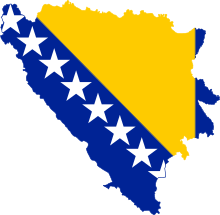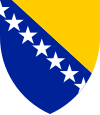National symbols of Bosnia and Herzegovina
(Redirected from
Symbols of Bosnia and Herzegovina
)This article includes a list of general references, but it lacks sufficient corresponding inline citations. (January 2014) |

The national symbols of Bosnia and Herzegovina are flags, icons or cultural expressions that are emblematic, representative or otherwise characteristic of Bosnia and Herzegovina or culture of nations in Bosnia and Herzegovina. As a rule, these symbols are cultural icons that have emerged from folklore and tradition of nations in Bosnia and Herzegovina, meaning few have any official status.
Flags

|
Serbs.[1]
|
Heraldry

|
The coat of arms of Bosnia and Herzegovina was adopted in 1998, replacing the previous design that had been in use since 1992 when Bosnia and Herzegovina gained independence, and follows the design of the national flag. The three pointed shield is specific and is to symbolize the three major ethnic groups of Bosnia, as well as allude to the shape of the country. The stars were adopted to replace the fleur de lys. |

|
Fleur-de-lis. The coat of arms of the medieval Kingdom of Bosnia contained six fleurs-de-lis, likely drawing inspiration from the native Bosnian or Golden Lily, Lilium bosniacum. This emblem was revived in 1992 as a national symbol of the Republic of Bosnia and Herzegovina (mainly for Bosniaks) and was on the flag of Bosnia and Herzegovina from 1992 to 1995.[2] Today, symbol appears in the flags and arms of many cantons, municipalities, cities and towns of Bosnia and Herzegovina and is used by Bosniaks as their national symbol. |
Anthem
Državna himna Bosne i Hercegovine is the national anthem of Bosnia and Herzegovina. It is one of the two national anthems (along with that of Spain) in the world to have no official lyrics.[3] The anthem was adopted on 25 June 1999, by the promulgation of the Law on the National Anthem of Bosnia and Herzegovina,[4] replacing the previous anthem, Jedna si jedina
|
Flora and fauna

|
Bosnian Kingdom and Bosnia . The Coat of arms used by the members of the House of Kotromanić, sovereigns of medieval Bosnia and the surrounding lands, consisted of six golden lilies on a blue background with a white ribbon. Today is used as the national symbol of Bosniak community.
|
Food and drink

|
southeastern Europe. They are considered a national dish in Bosnia and Herzegovina .
|

|
krompiruša. All these varieties are generically referred to as pita (Serbian, Bosnian and Croatian for pie). |

|
Sarma is a dish of grape, cabbage or chard leaves rolled around a filling usually based on minced meat, or a sweet dish of filo dough wrapped around a filling often of various kinds of chopped nuts. The Bosnian type includes rice and minced meat, as well as dried smoked beef. |

|
The Livno cheese is a cheese first produced in the 19th century in the area of Livno, region of Tropolje, on the basis of French technology of making the Gruyère cheese. Originally, it was made from sheep's milk and nowadays it is mainly made from a mixture of sheep's and cow's milk. |

|
Bosnian coffee is a type of Turkish coffee. Difference from the Turkish preparation is that when the water reaches its boiling point, a small amount is saved aside for later, usually in a coffee cup. Then, the coffee is added to the pot (džezva), and the remaining water in the cup is added to the pot. Everything is put back on the heat source to reach its boiling point again, which only takes a couple of seconds since the coffee is already very hot. Coffee drinking in Bosnia is a traditional daily custom and plays an important role during social gatherings. |
People

|
Saint Elijah is the patron saint of Bosnia and Herzegovina since 1752.[5]
|

|
Blessed Catholics traditionally mark 25 October with a mass in Bobovac at the altar of the homeland.
|

|
Diva Grabovčeva is a Roman Catholic virgin martyr, a symbol of the resistance of Bosnian and Herzegovinian Catholics to the Turks. |
|
Kulin Ban
is the Ban of Bosnia from 1180 to 1204. He was Bosnia's most prominent and notable ruler. His most noteworthy diplomatic achievement was the Charter of Ban Kulin, Bosnian; Povelja Kulina Bana, which encouraged trade and established peaceful relations between his country of Bosnia and Dubrovnik.
Architecture

|
necropoleis.[9]
|

|
|

|
The Mehmed Paša Sokolović.[13] UNESCO included the facility in its 2007 World Heritage List.
|

|
The Cardinal Vinko Puljić, and center of Catholic worship in the city. The Cathedral is located in the city's Old Town district. It was designed by Josip Vancaš as a triple-aisled church in the eclectic manner, with neo-Gothic elements predominating. The tomb of Josip Stadler , the first Archbishop of Vrhbosna, is located in the Cathedral.
|

|
The Gazi Husrev-beg Mosque (Bosnian: Gazi Husrev-begova Džamija, Turkish: Gazi Hüsrev Bey Camii), is a mosque in the city of Sarajevo, Bosnia and Herzegovina. It is considered the most important Islamic structure in the country and one of the world's finest examples of Ottoman architecture. It is located in the Baščaršija neighborhood in the Stari Grad municipality, and remains one of the most popular centers of worship in the city. |

|
Austro-Hungarian Empire . It is the only functioning synagogue in Sarajevo today.
|
Other symbols

|
Bosnian Cyrillic widely known as Bosančica[15][16] is an extinct type of the Cyrillic alphabet that originated in Bosnia and Herzegovina.[17] It was widely used in Bosnia and Herzegovina and the bordering areas in Croatia (southern Dalmatia and Dubrovnik regions). |
References
- ^ "Outside world chooses new flag for Bosnia". The Independent. 5 February 1998. Archived from the original on 2022-06-18. Retrieved 2 July 2013.
- ^ "Republic of Bosnia and Herzegovina, 1992-1998". Flagspot.net. Retrieved 2 July 2013.
- ^ "Spain - Marcha Real". NationalAnthems.me. Retrieved 2011-11-23.
- ^ Office of the High Representative (25 June 1999). "Decision imposing the Law on the National Anthem of BiH". Retrieved 10 May 2010.
- ^ "Sveti Ilija - zaštitnik Bosne i Hercegovine" (in Croatian). vecernji.ba. 21 July 2012. Retrieved 2 July 2013.
- ^ a b c Velkonija 2003, p. 33
- OCLC 457893641.
- OCLC 716361786.
- ^ Centre, UNESCO World Heritage. "Stećci Medieval Tombstone Graveyards". UNESCO World Heritage Centre. Retrieved 25 June 2021.
- ^ Balić, Smail (1973). Kultura Bošnjaka: Muslimanska Komponenta. Vienna. pp. 32–34.
{{cite book}}: CS1 maint: location missing publisher (link) - ^ Čišić, Husein. Razvitak i postanak grada Mostara. Štamparija Mostar. p. 22.
- ISBN 0-684-12582-X.
- ^ Sokollu Mehmed Pasha Bridge at Structurae
- ^ Katolička Tiskovna Agencija
- ^ Balić, Smail (1978). Die Kultur der Bosniaken, Supplement I: Inventar des bosnischen literarischen Erbes in orientalischen Sprachen. Vienna: Adolf Holzhausens, Vienna. pp. 49–50.
- ^ Algar, Hamid (1995). The Literature of the Bosnian Muslims: a Quadrilingual Heritage. Kuala Lumpur: Nadwah Ketakwaan Melalui Kreativiti. pp. 254–68.
- ^ Balić, Smail (1978). Die Kultur der Bosniaken, Supplement I: Inventar des bosnischen literarischen Erbes in orientalischen Sprachen. Vienna: Adolf Holzhausens, Vienna. pp. 78–80.

